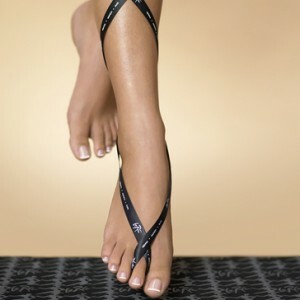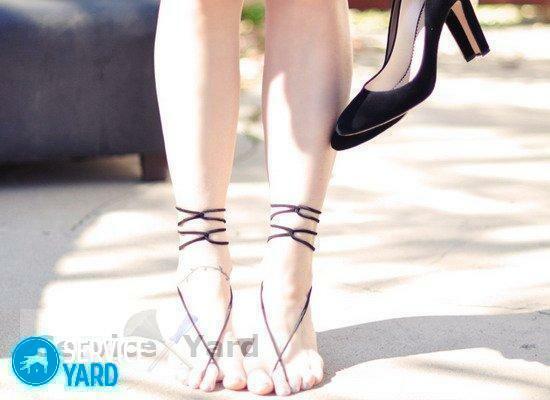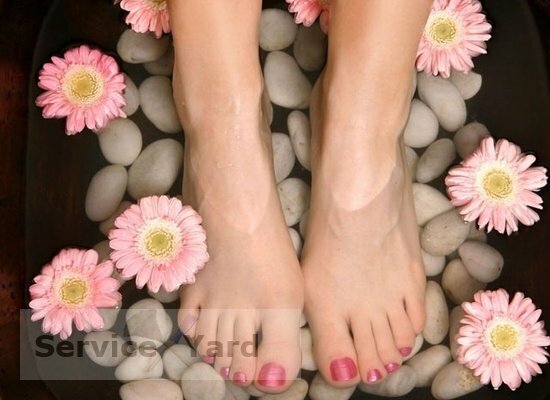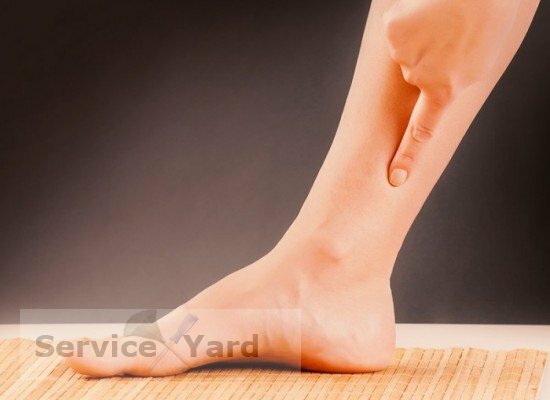
- Kinds of fungus on the legs
- Causes of the appearance of fungi
- Forms of fungus on the legs
- Symptoms of the fungus on the legs
- Fungus test at home
- How to cure the fungus by medical means?
- Folk remedies for fungus
- Preventative measures
- Additional conditions for effective treatment
Fungus on the legs is a fairly common disease. Every 10 inhabitants of the planet are familiar with it. This disease is caused by microorganisms and brings, to a greater extent, the aesthetic problem than the physical one. But it should be remembered that fungi, actively multiplying on the skin and nails of a person, secrete toxins that get into the blood. For many years, the products of the life of microorganisms can poison the body, depress the immune system, affecting all organs.
to the contents ↑Types of fungus on the legs
The situation is further aggravated by the fact that many people do not even suspect that they are carriers of the fungus, as it settles and develops completely unnoticeably. In nature, there are a large number of species of fungi, but only a few cause the disease in humans.
 To microorganisms affecting the feet, the following groups of fungi belong:
To microorganisms affecting the feet, the following groups of fungi belong:
- Anthropophilic. Only humans cause disease. You can get infected only from a sick person.
- Zoo anthropophilic. Not only people but animals are affected. You can get infected from a sick person and, accordingly, from an animal.
- Candida. This kind of organisms is constantly present on the surface of the human skin. It becomes pathogenic only with a significant decrease in immunity. May enter the body from the surface of public objects.
Important! As soon as the primary symptoms of the fungus on the legs appear, you must immediately take the medication. To ensure that your efforts are not in vain, approach the solution of the problem with knowledge of the case. From the beginning, establish the cause of the appearance of a fungal infection.
to the contents ↑Causes of the appearance of fungi
In order for the disease to appear, at least several mandatory conditions for the development of fungus on the legs are necessary. These include:
- Weak immunity. Decreased immunity can cause various endocrine and vascular diseases, for example, varicose veins, diabetes, flat feet, and stress can also provoke the infection.
- Excessive sweating or, conversely, dryness of the feet. The easy ways to penetrate the skin of the fungus may be abrasions, cracks between the toes, caused by excessive sweating or vice versa, dryness of the feet. When wearing too narrow shoes, there are also various scrapes of the skin. With poor wiping of feet after water procedures, various abrasions and cracks can also appear, where parasites can easily penetrate.
- Increased vulnerability of the nail or skin of the foot, which occurs after a pedicure. Protection of cuticle or keratinized skin after this procedure is not available.
- Wet shoes and socks. To reproduce the fungus, moist and warm conditions are needed, which kindly provide poor-quality shoes or wet socks.
Important! Each person, the features of immunity are different, so do not use someone else's shoes and hygiene items.
- Inadequate foot hygiene.
- Close contact with the patient. Excessive use of antibacterial drugs.
Important! Transfer of fungus to the beach is unlikely: dry sand and sea water act on microorganisms disastrous .
to content ↑Forms of fungus on legs
Fungal lesions are divided into 2 types: those that appear on the skin of the foot or on the nails.
Important! The disease of feet is united under the general term "mycosis stop".The forms of foot diseases are different and often combine with each other. Sometimes, at the initial stage, the disease appears only on one foot, and then goes on to the next.
Symptoms of fungal infection of the feet:
- on the skin of the foot there is a reddening area, which later flakes;
- itching and soreness in the lesion;
- can appear small bubbles that merge into larger ones, forming erosion.
Important! Continuation of a long-term infection of the foot can appear onychomycosis - damage to the nail plates. This disease can also appear as a primary fungal lesion.
to the table of contents ↑Symptoms of the fungus on the legs
When selecting antifungal drugs, it is important to know the name of the pathogen. The most common are: Trichophyton interdigitale, Epidermophyton floccosum, Trichophyton rubrum. Typical symptoms for this disease can be:
- nail blackening;
- deformation of the shape of the nail plate;
- the nail becomes brittle and frayed;
- pain and itching at the tips of your toes;
- unpleasant odor;
- nails can grow into the skin or form cavities.
Important! Accompany these symptoms can and the appearance of other skin diseases, such as psoriasis, eczema and allergic dermatitis. When the first symptoms of infection appear, take emergency measures urgently to cure the fungus on the legs and it does not spread further down the skin.
to the table of contents ↑Fungus test at home
If you are in doubt about the presence of fungus, then perform the following screening test:
- Dilute the crystals of potassium permanganate in warm water until a solution of violet is obtained.
- Put the feet in the solution for a while.
- Note the color of the nail: the affected areas will become light, and not affected will be brown.
That's it! If a skin condition is found, contact a dermatologist who will refer you to the tests. In the event that a particular fungus is identified on the legs, the treatment will be more rapid and effective.
to the contents ↑How to cure a fungus by medical means?
To date, there are many antifungal drugs that can effectively fight infection. In order to fully recover, you must take the medicine for a long time and in fairly large doses.
Antibiotics and antifungal agents
 The best effect from the use of drugs is achieved with the method of pulse therapy: shock doses of an antifungal agent are applied in short courses followed by a long break.
The best effect from the use of drugs is achieved with the method of pulse therapy: shock doses of an antifungal agent are applied in short courses followed by a long break.
Important! Itraconazole is taken within 3 months of courses. It is suitable both for the treatment of feet and nails. Systemic antibiotics also include: ketoconazole, terbinafine, fluconazole, griseofulvin. They are usually used not only in the form of ointments, but also tableted preparations for oral administration as a complex therapy. This method of reception allows you to simultaneously clear the pathogen from the patient's blood.
Despite the prevailing opinion about the safety of such drugs, all preparations for the treatment of mycosis are very toxic, so they need to be taken only under medical supervision.
Topical application
For topical treatment of the fungus, topical solutions can also be used: gels, ointments, creams, suspensions, varnishes, etc. The more dry your skin, the more fatty the substrate you need to choose:
- for heels will suit the ointment;
- for interdigital space - gel or suspension;
- for nails use special varnishes.
Important! The most effective are the following medical devices:
- Lamisil, Atifin, Exifin, Terbix, Terbinafine, Fungoterbine - based on the active substance terbinafine.
- Batrafen and Kislopiroxolamine - based on cyclopyroxolamine;
- Zalain - based on sertokanazole;
- Exoteril - based on naphthyfine;
- Nizoral and Mikozoral - based on ketoconazole.
Diagram of effective treatment of
To cure fungus on legs quickly, consider these recommendations:
- Use systemic antifungal agents together with local antifungal agents.
- In the initial stages, only topical preparations may be used.
Important! Treatment during pregnancy can cause undesirable consequences, so refrain from using serious funds before delivery or until the end of the lactation period.
to content ↑Folk remedies for fungus
Folk methods can be used isolated only at the earliest stage of the disease, or use them as an adjunct to basic therapy. In case you are afraid of being exposed to the risk of toxic contamination of the body, also use simple and effective home recipes to combat your problem. All of the proposed remedies can alleviate the symptoms, and often completely solve the problem of how to cure the fungus on the legs.
Salt and iodine
Using this method, remember that you need to adhere to discipline, and most importantly - the desire to get rid of the disease, and perform the procedures in this order:
- Begin the daily procedure with a salt bath: pour salt into the hot water( 70 C)( preferably sea) and add the soda in the following proportions: 2 tbsp.l.salt, 1 tbsp.l.soda for 1 liter of water.
- Dip your feet in the solution for 30 minutes.
- Do not remove the legs from the bath, cleanse the affected areas on the skin and nails as much as possible: cut the nail with scissors and work with the nail file as much as possible, sand the feet with a saw or stone.
- Wash feet with soap and treat them with hydrogen peroxide.
Important! Use gloves to protect your hands.
- Dry your feet with a tissue.
- Treat iodine on the surface of the foot, the area between the fingers and the hypodermic ridges.
- Apply iodine to affected areas 3 times after each drying( if you are treating a fingernail, soak iodized sections several times).
- After the procedure, apply a softening cream to the feet.
- Repeat the procedure every day for a month.
Important! As you can see, it will take a lot of effort to cure the fungus on legs, but you will be sure of the result and warn the repeated infection in the near future.
Tray footstools
 Another option for getting rid of the fungus on the legs involves the use of a vegetable infusion:
Another option for getting rid of the fungus on the legs involves the use of a vegetable infusion:
- To prepare the broth, take 3 large sheets and pour 2 liters of water.
- Boil the mixture for 15 minutes on low heat. Insist the solution for 3-4 hours.
- Strain.
- Pour the solution into a container and lower the legs for 40-45 minutes.
- After the bath, treat the feet with apple cider vinegar.
- Wear clean socks.
- Repeat procedure every 2-3 days. Treatment last a month or until the fungus completely disappears.
Important! Trays with milk can be alternated with saline. In this case, the fungus on legs will go much faster.
Salt infusion of garlic
A good effect is the treatment of fungus infusion of salt and garlic. Proceed as follows:
- 1 tsp.salt in 1 liter of water.
- At 1 tbsp.l. Add 1 large clove of crushed garlic.
- Strain and wring through gauze.
- Add to the mixture 4 tbsp.l.of the prepared brine.
- Finish the affected area 2 times a day with a ready-made product.
Important! For treatment, prepare a fresh solution each time.
Cleaner
If you have celandine growing in your cottage, then use its juice, which has a strong antifungal effect:
- Tear off the plant.
- Apply orange juice to the affected areas
Important! Immediately itching will be felt, but as the juice is soaked, unpleasant sensations will pass.
- After a couple of minutes, grease the area with the juice again.
- Do this 3-4 times.
- Apply the juice 2 times a day for a month.
Dry celandine grass can be used for compresses:
- Crush the celandine into powder.
- Mix the resulting mass with the tea tree oil until a thick emulsion is obtained.
- Put the mixture in the form of compresses on the affected areas daily until the fungus does not come off( or the new nail will not grow).
Important! This treatment for the fungus on the legs received many positive reviews and is widely used in folk medicine as the simplest and most affordable means.
Decoction of medicinal herbs for affected areas
Use the following ingredients:
- oak bark;
- inflorescence of calendula;
- verbena medicinal( herb);
- blackberry( dried berries);
 From the ingredients listed, prepare a decoction:
From the ingredients listed, prepare a decoction:
- Mix everything in equal quantity.
- 3 tbsp.l.of the mixture, pour 1 tbsp.water.
- Put the product on a small fire for 25-30 minutes.
- Strain the broth.
- Use for lotions and flushing lesions.
Important! Do not immediately prepare a large amount of infusion for the entire course of therapy. It is better to make the broth in small portions. A fresh remedy is more effective for treating the fungus on the legs than a week or two.
Ointment against fungus
Ointment can be prepared at home and applied to the feet before bedtime until the fungus completely disappears. Preparation scheme:
- 2 Fresh chicken eggs, pour 70% acetic acid.
- Leave in a dark place until the shell dissolves completely.
- Add 200 g of butter and 4 tbsp.l.acetic acid.
Ointment from the foot fungus
To cure the fungus, you can use this method. You will need goose or pork fat, yellow sulfur, copper vitriol. Prepare the ointment as follows:
- Mix in equal amounts all the ingredients.
- Mix thoroughly until smooth.
- Put the mixture on a fire and bring to a boil.
- Place the product in a dark place until completely cooled.
- Lubricate affected areas with prepared ointment once a day.
Composition for the treatment of nail fungus from available medicines
To prepare the product you will need medical alcohol, acetic essence and glycerin. Prepare the composition as follows:
- 2 tsp.of medical alcohol mix thoroughly with 2 tsp.acetic essence and 1 tsp.glycerin.
- Take the resulting liquid on the affected area of the nail.
Follow the procedure until the affected nail is gone.
Important! Prepare the prepared composition directly on the damaged nail plate. Avoid contact with skin.
to content ↑Preventative measures
It is much more appropriate to initially prevent the disease than to look for ways and methods of treating the fungus on the legs. Adhere to simple rules:
- Never wear other people's shoes. On a visit, refuse from the slippers offered to you( take your changeable shoes on a visit).
- Do not allow the feet to overheat.
- In time, change socks and dry the soaked and sweaty shoes.
- Do not use other instruments for pedicure.
- When visiting a solarium, swimming pool, sauna, bath or therapeutic bath, do not forget to bring rubber slippers.
- Do not go barefoot in hotels, sports locker rooms and other public places.
- Use in the bathroom and shower rubber mats, as they can always be showered with hot water for prevention.
- After taking a shower or bath, thoroughly wipe your feet, especially the area between your fingers.
- When buying, do not measure shoes on a bare foot.
- Keep track of your legs, take care of them properly, take corrective measures when sweating, dryness, calluses occur, do not allow cracks to appear on your legs.
- If you suspect that you picked up the fungus after visiting public places, when you come home, treat your feet with a cotton swab dipped in a 6% solution of table vinegar or wash them with tar soap.
Important! Observing such simple rules, you do not have to wonder how to cure the fungus on your legs - they will always be in order.
to the contents ↑Additional conditions for effective treatment of
Whatever method of treatment of the fungus you have not chosen, before treatment, be sure to treat all shoes, socks, carpets, bathtubs, etc. Use for this purpose boiling, ironing, vinegar, for shoes apply a specialformalin. After processing - put the shoes in a bag.
If the disease appears in someone from family members, take the necessary precautions: until the patient cures the fungus, do not let him walk around the house barefoot, and also sit with his feet on the sofa, chair. Before taking a bath, wash the surface with any liquid detergent with chlorine, which will kill the fungus. Scissors, nail files wipe with alcohol.
Follow the listed precautions and precautions and remember that the disease is easier to prevent than treat!
